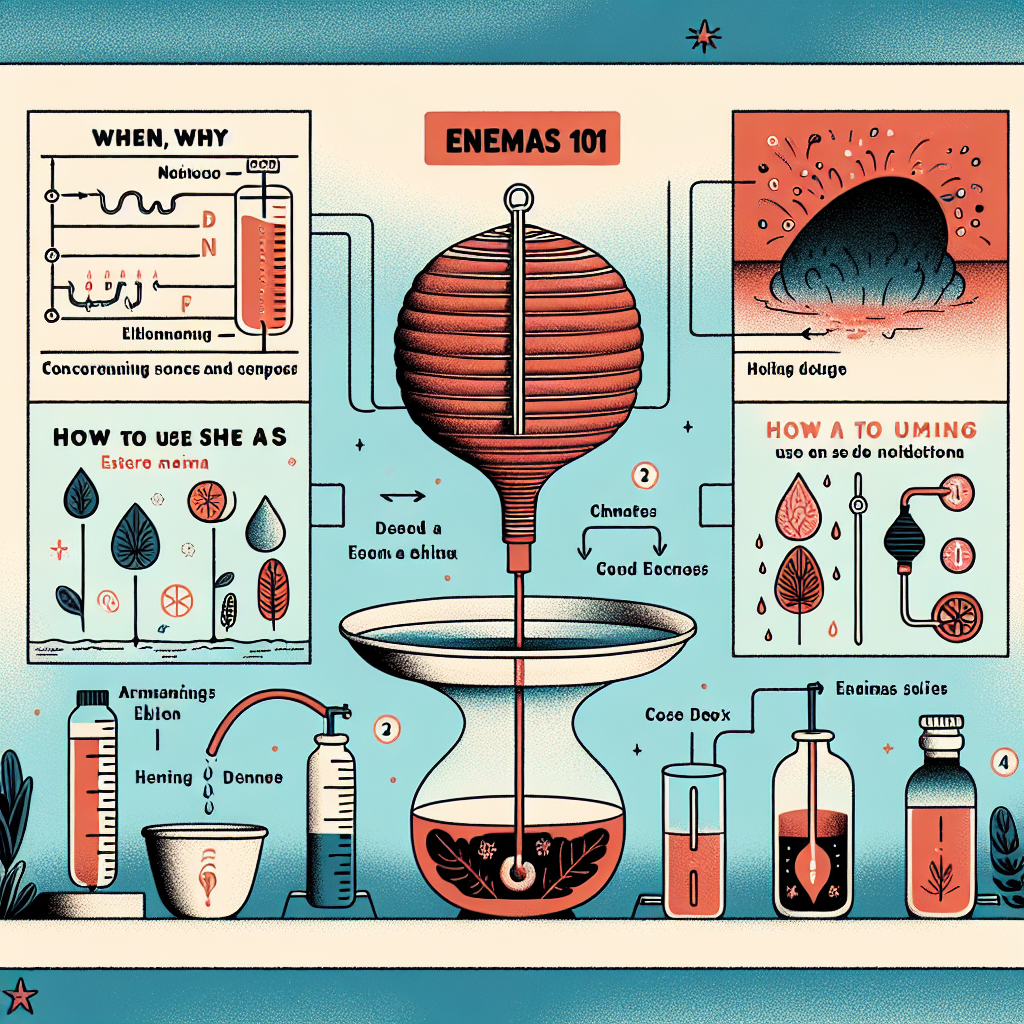Enemas 101: When, Why, and How to Use Them for Detox

Discover more about Enemas 101: When, Why, and How to Use Them for Detox. Learn the benefits, the right time to use them, and the proper way to do it for an effective detox. Visit My Vibrant Vitality now!
Understanding the Timing: When to Use Enemas for Detox
Enemas have been used for centuries as a method of detoxification, helping to cleanse the body of harmful toxins and waste. However, understanding the timing of when to use enemas for detox is crucial to ensure their effectiveness and safety.
Enemas are typically used when the body shows signs of toxic overload. These signs can include chronic fatigue, frequent headaches, skin problems, digestive issues, and even mood swings. When these symptoms persist, despite a healthy diet and regular exercise, it may be an indication that the body is struggling to eliminate toxins effectively. In such cases, an enema can be a beneficial tool to aid in detoxification.
However, it’s important to note that enemas should not be used as a first-line treatment for these symptoms. They should be considered only after other lifestyle changes, such as improving diet and increasing physical activity, have been implemented and have not resulted in significant improvement.
The timing of enemas can also be influenced by the type of enema being used. For instance, coffee enemas, which are often used for detoxification, are typically recommended in the morning. This is because the caffeine in the coffee can stimulate the liver and gallbladder to release toxins, which can then be eliminated through the colon. However, performing a coffee enema too close to bedtime could interfere with sleep due to the caffeine content.
On the other hand, saline or water-based enemas can be performed at any time of the day, as they do not contain any stimulants. These types of enemas work by softening the stool and promoting bowel movements, which can help to remove toxins from the body.
It’s also important to consider the frequency of enemas. While they can be a useful tool for detoxification, overuse can lead to dehydration and electrolyte imbalances. As a general rule, enemas should not be used more than once a week for detox purposes, unless under the supervision of a healthcare professional.
In addition, it’s crucial to listen to your body when considering the timing of enemas. If you feel weak or dizzy after an enema, it may be a sign that your body needs time to recover. In such cases, it’s advisable to wait at least a few days before performing another enema.
In conclusion, the timing of enemas for detoxification can depend on a variety of factors, including the type of enema, the frequency of use, and individual health status. It’s always recommended to consult with a healthcare professional before starting any new detox regimen, including enemas. They can provide personalized advice based on your specific health needs and ensure that you are using enemas safely and effectively. Remember, while enemas can be a beneficial tool for detoxification, they should be used as part of a balanced approach to health and wellness, which includes a healthy diet, regular exercise, and adequate rest.
The Science Behind Enemas: Why They are Used for Detoxification

Enemas have been used for centuries as a method of detoxification, and despite the controversy surrounding their use, they continue to be a popular choice for many individuals seeking to cleanse their bodies. The science behind enemas and their detoxifying properties is fascinating, and understanding it can help you make an informed decision about whether this method is right for you.
The human body is a complex system that naturally detoxifies itself. The liver, kidneys, and intestines all play crucial roles in this process, filtering out toxins and waste products from the bloodstream and eliminating them from the body. However, in today’s world, we are exposed to an unprecedented number of toxins, from the food we eat to the air we breathe. This can put a strain on our natural detoxification systems, leading to a buildup of toxins in the body. This is where enemas come in.
An enema is a procedure that involves introducing a liquid, usually water or a solution of water and other substances, into the rectum and colon. This is done using a special bag or bulb and a tube, which is inserted into the rectum. The liquid is then released into the colon, where it softens and loosens the stool. This can stimulate a bowel movement, helping to expel waste from the body.
But how does this help with detoxification? The answer lies in the unique structure and function of the colon. The colon, or large intestine, is the final part of the digestive tract. Its primary function is to absorb water and electrolytes from the remaining indigestible food matter, and to transport the waste material out of the body. However, the colon is also home to a vast community of bacteria, known as the gut microbiota. These bacteria play a crucial role in our health, aiding in digestion, producing vitamins, and protecting against harmful pathogens.
When the colon is overloaded with toxins, it can disrupt the balance of the gut microbiota, leading to a range of health problems, from digestive issues to weakened immunity. By flushing out the colon, enemas can help to restore this balance, promoting a healthier gut microbiota and aiding in detoxification.
Moreover, enemas can also stimulate the liver, one of the body’s primary detoxification organs. The liver produces bile, a substance that helps to break down fats and remove toxins from the body. By stimulating the liver, enemas can increase bile production, further aiding in detoxification.
However, it’s important to note that while enemas can aid in detoxification, they are not a cure-all solution. They should be used as part of a broader detoxification strategy, which includes a healthy diet, regular exercise, and plenty of water. Additionally, enemas should always be performed under the guidance of a healthcare professional, as improper use can lead to complications.
In conclusion, enemas can be a useful tool for detoxification, helping to cleanse the colon, restore the balance of the gut microbiota, and stimulate the liver. However, they should be used responsibly and as part of a comprehensive detoxification plan. As always, it’s important to consult with a healthcare professional before starting any new health regimen.
A Step-by-Step Guide: How to Use Enemas for Detox Purposes
Enemas have been used for centuries as a method of detoxification, and despite the advent of modern medicine, they continue to be a popular choice for many individuals seeking to cleanse their bodies. The process involves the introduction of a liquid, often a solution of water and other substances, into the rectum and colon. This is done with the aim of stimulating bowel movements and flushing out accumulated waste and toxins. However, the use of enemas for detoxification should not be undertaken lightly, as it requires a certain level of knowledge and preparation.
The first step in using an enema for detoxification is to understand when it is appropriate to use one. Enemas are typically recommended for individuals who suffer from chronic constipation or irregular bowel movements. They can also be beneficial for those who are embarking on a detox or cleanse program, as they can help to expedite the removal of toxins from the body. However, it is important to note that enemas should not be used as a regular method of bowel regulation, as overuse can lead to dependency and disrupt the natural balance of bacteria in the gut.
Once you have determined that an enema is appropriate, the next step is to decide on the type of enema to use. There are several types available, each with its own benefits and drawbacks. Saline enemas are the most common and are generally considered safe and effective. Coffee enemas are another popular choice, as the caffeine in the coffee is believed to stimulate the liver and gallbladder to release toxins. However, coffee enemas should be used with caution, as they can cause dehydration and electrolyte imbalances if not properly administered.
The process of administering an enema for detoxification purposes is relatively straightforward, but it does require some preparation. First, you will need to purchase an enema kit, which typically includes a bag or bucket to hold the liquid, a tube to deliver the liquid into the rectum, and a nozzle or tip that is inserted into the rectum. The liquid solution should be prepared according to the instructions provided with the kit, and it should be warmed to body temperature to prevent discomfort during administration.
To administer the enema, you will need to lie on your side on a comfortable surface, such as a bed or a mat on the floor. The nozzle of the enema kit should be gently inserted into the rectum, and the liquid should be slowly released into the colon. It is recommended to hold the liquid in for at least 15 minutes to allow it to fully penetrate the colon and stimulate a bowel movement. After this time, you can release the liquid into the toilet.
In conclusion, enemas can be an effective method of detoxification when used appropriately. However, they should not be used as a regular method of bowel regulation, and they should always be administered with care and preparation. If you are considering using an enema for detoxification purposes, it is recommended to consult with a healthcare professional to ensure that it is safe and appropriate for your individual health needs.